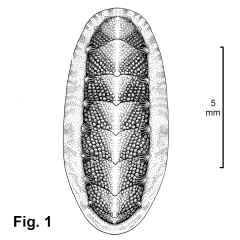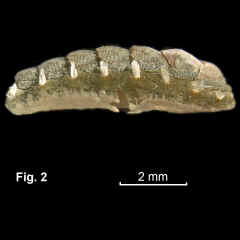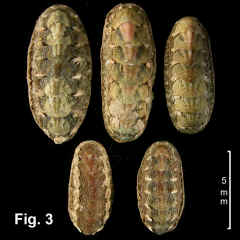|
|
ACANTHOCHITONIDAE |
|
|
|
Acanthochitona retrojecta (Pilsbry, 1894) Description: Animal ovate, narrowly elongate, girdle broad; valves often eroded. Median valves with jugal area not differentiated, sculptured with small pustules; lateral and pleural areas not differentiated, with moderate sized to large pustules, aligned or randomly placed. Girdle with tufts of fine spicules that clump together when wet, one beside each median valve and 4 in front of anterior valve; rest of girdle naked. Colour very variable from fawn to dark brown, usually decorated with green or pink. Size: Up to 12 m in length. Distribution: Endemic to Australia: Low Isles, (off Port Douglas) Qld, southwards and around southern Australia to near Port Lincoln, SA, but not Tasmania. Habitat: Lives on the surfaces of rocks between mid-tide and low tide levels, in cracks and crevices, in mussel beds, among polychate tubes, around ascidians and in algal turf. Abundant in some locations. Comparison: In this species there is no jugal ridge, allowing the pustulose sculpture of the valves to extend across the dorsum. Remarks: The ecology of this species was studied by Kelaher & Cole (2005). They reported that it lives in what they regarded as complex habits: mussel beds, polychaete tubes, around ascidians, and in coralline algal turf. It was very common in algal turf around Sydney, reaching densities up to 3500 individuals per square metre. They found it more common in mid-shore areas than at low shore, and that recruitment continued throughout the year. Fig. 1: Composite drawing by Michael Shea of Australian Museum specimens. Fig. 2: Long Reef, Collaroy, NSW (C.148971) Girdle damaged at posterior. Fig. 3: Colour varieties. Middle Harbour, NSW. Dried specimens, collected pre-1912 (C.044936). |
|


